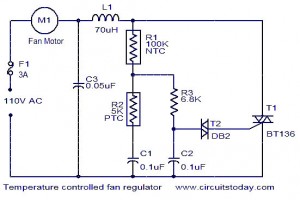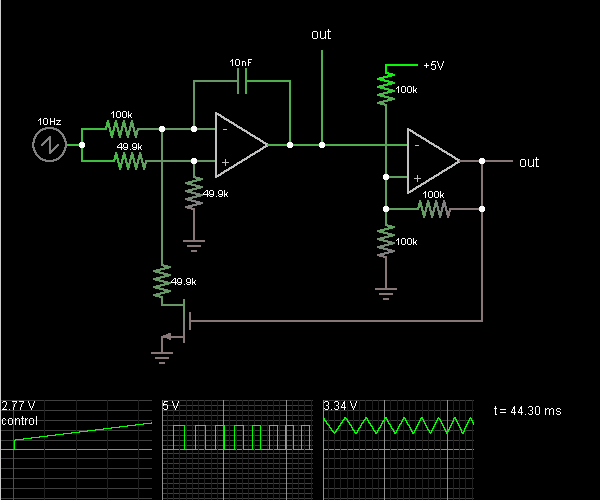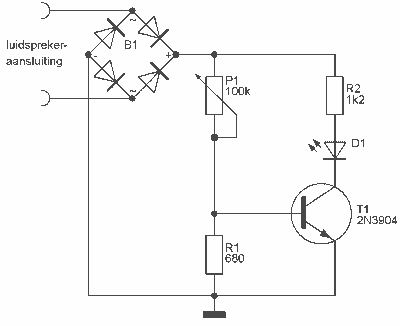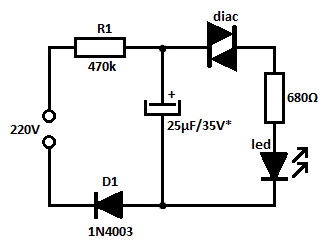
up down led sequencer
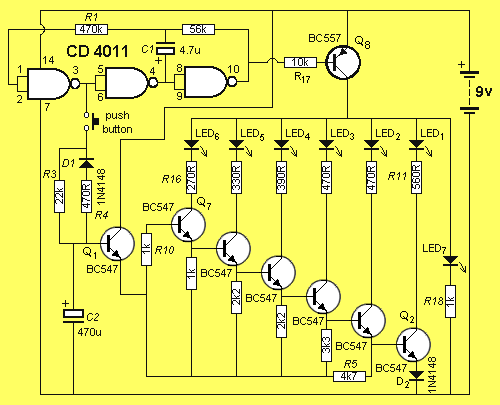
A 10-light LED bar graph is desired, where the LEDs light up sequentially until all are lit, then cycle back down until all are off. The LM3914 - Dot/Bar Display Driver is a simpler analog solution that operates in bar mode. By applying a triangular ramp voltage at the input, the LEDs will light up in sequence and then turn off in sequence. The user plans to order CD4011s, having only a few CD4013s available. They are considering improvising with the data sheets. A circuit was built using the LM3914, but issues arose when using a 555 timer as a triangle wave generator. The top and bottom LEDs remained lit for disproportionate amounts of time, complicating span and time constant adjustments. Adjusting one potentiometer affected the other. Thus, the user attempted to build a circuit using the CD4017 to utilize a pulse instead of a changing voltage, aiming for a more constant flow. They also plan to explore function generator chips as alternatives to the 555 timer for low-frequency operation. A suggestion was made that five LEDs would suffice. The user has searched for a suitable circuit but only found a Knight Rider circuit. A digital approach could involve using a bidirectional shift register, such as the 4-bit CD40194, which can be connected in series. The LEDs would connect to the shift register's parallel outputs through drivers. The "shift right" direction would be set to logic high ("1"), illuminating each LED on each clock pulse. Upon reaching the last LED, the shift direction would reverse, with "shift left" connected to "0", turning off each LED sequentially. Logic is required to generate the up/down control signal for the shift register, which could consist of a flip-flop that controls the direction based on its state at the beginning and end counts.
The design of the LED bar graph circuit can effectively utilize the LM3914 in bar mode, providing a straightforward method for sequentially illuminating the LEDs. The triangular ramp voltage applied to the input of the LM3914 is critical for achieving the desired sequential lighting effect. The ramp voltage should be generated with a stable waveform to ensure consistent timing for each LED. However, the challenges faced with the 555 timer indicate that an alternative waveform generator or a more stable control circuit may be necessary for precise control over the timing and illumination duration of the LEDs.
Transitioning to a digital approach with the CD40194 shift register offers a robust solution that can simplify the control of the LEDs. Each LED can be driven by the outputs of the shift register, which can be easily expanded by cascading multiple CD40194s if more than four LEDs are required. The clock pulses can be generated using a simple oscillator circuit, which can be designed to provide the necessary frequency for illuminating the LEDs at the desired speed.
The control logic for the shift register can be implemented using a flip-flop that toggles its state based on a counter, determining whether to shift the output to the right or left. This allows for a seamless transition from lighting the LEDs to extinguishing them, creating an appealing visual effect. Care should be taken to ensure that the control signals are debounced to prevent erratic behavior during operation.
In summary, this circuit design combines both analog and digital techniques to create a visually engaging LED bar graph display. The choice between using the LM3914 or the CD40194 shift register will depend on the specific requirements for timing, control, and complexity, but both methods offer viable paths to achieve the desired sequential lighting effect.I have a 10 light LED bargraph, I want to make the LED`s light one after the other until all the LED`s are lit, and then have the circuit cycle back down until all the LED`s are off again. A simpler (analog) way is a LM3914 - Dot/Bar Display Driver operating in the bar mode. If you put a triangular ramp voltage at the input, the LEDs will light up in sequence, and then go out in sequence. I`ll have to order some cd4011`s tomorrow. I only have a few cd4013`s in my parts bin. I`ll look at the data sheets and see if I can improvise. Thanks for the schematic Collin55. I built a circuit using a LM3914. The only problem I ran into was using a 555 as a triangle wave generator. The top and bottom LED`s would stay lit for a disproportionate time, and it was hard to adjust the span and time constant. If I turned one pot it would affect the range on the other. That`s why I tried building the circuit using the 4017. I wanted to make something that would use a pulse instead of depending on a changing voltage. I was hoping to make the flow seem more constant. I`ll also look into the function generator chips Crutschow, might be a good alternative to a 555, especially since I`m trying to run it at a very low frequency.
Boncuk, 5 LED`s would be fine. I`ve been searching high and low for a circuit I could use to do this, but all I could find was a Knight Rider circuit. Do you have a schematic One digital approach would be to use a bidirectional shift register such as the 4-bit CD40194.
You can connect as many in series as you need. You would connect the LEDs to the shift-register parallel outputs (through drivers). Then you connect the "shift right" direction to logic high ("1"). This will sequentially illuminate each LED on each clock pulse. When you get to the last LED you reverse the shift direction, with the "shift left" connected to "0". This will sequentially turn off each LED. You will need some logic to generate the up/down control signal for the shift-register. The could consist of a flip-flop that controls the direction with its state changing at the beginning count and the end count.
acquiring knowledge is like doing a jig saw puzzle, many of the bits on their own dont make sense, but they are all needed to give a complete picture. "Eric Gibbs" I don`t see a big difference between using a pull down resistor and omitting it. At VDD=12V and a pull down resistor of 10K © the base voltage is 3. 97274e-08 with a low counter output. Without pull down resistor it is 5. 20027e-06 which are both far below any voltage to allow collector current flow. LEDs 1 and 5 which are switched without diodes have a low level base voltage of 2. 7623e-08. 🔗 External reference
The design of the LED bar graph circuit can effectively utilize the LM3914 in bar mode, providing a straightforward method for sequentially illuminating the LEDs. The triangular ramp voltage applied to the input of the LM3914 is critical for achieving the desired sequential lighting effect. The ramp voltage should be generated with a stable waveform to ensure consistent timing for each LED. However, the challenges faced with the 555 timer indicate that an alternative waveform generator or a more stable control circuit may be necessary for precise control over the timing and illumination duration of the LEDs.
Transitioning to a digital approach with the CD40194 shift register offers a robust solution that can simplify the control of the LEDs. Each LED can be driven by the outputs of the shift register, which can be easily expanded by cascading multiple CD40194s if more than four LEDs are required. The clock pulses can be generated using a simple oscillator circuit, which can be designed to provide the necessary frequency for illuminating the LEDs at the desired speed.
The control logic for the shift register can be implemented using a flip-flop that toggles its state based on a counter, determining whether to shift the output to the right or left. This allows for a seamless transition from lighting the LEDs to extinguishing them, creating an appealing visual effect. Care should be taken to ensure that the control signals are debounced to prevent erratic behavior during operation.
In summary, this circuit design combines both analog and digital techniques to create a visually engaging LED bar graph display. The choice between using the LM3914 or the CD40194 shift register will depend on the specific requirements for timing, control, and complexity, but both methods offer viable paths to achieve the desired sequential lighting effect.I have a 10 light LED bargraph, I want to make the LED`s light one after the other until all the LED`s are lit, and then have the circuit cycle back down until all the LED`s are off again. A simpler (analog) way is a LM3914 - Dot/Bar Display Driver operating in the bar mode. If you put a triangular ramp voltage at the input, the LEDs will light up in sequence, and then go out in sequence. I`ll have to order some cd4011`s tomorrow. I only have a few cd4013`s in my parts bin. I`ll look at the data sheets and see if I can improvise. Thanks for the schematic Collin55. I built a circuit using a LM3914. The only problem I ran into was using a 555 as a triangle wave generator. The top and bottom LED`s would stay lit for a disproportionate time, and it was hard to adjust the span and time constant. If I turned one pot it would affect the range on the other. That`s why I tried building the circuit using the 4017. I wanted to make something that would use a pulse instead of depending on a changing voltage. I was hoping to make the flow seem more constant. I`ll also look into the function generator chips Crutschow, might be a good alternative to a 555, especially since I`m trying to run it at a very low frequency.
Boncuk, 5 LED`s would be fine. I`ve been searching high and low for a circuit I could use to do this, but all I could find was a Knight Rider circuit. Do you have a schematic One digital approach would be to use a bidirectional shift register such as the 4-bit CD40194.
You can connect as many in series as you need. You would connect the LEDs to the shift-register parallel outputs (through drivers). Then you connect the "shift right" direction to logic high ("1"). This will sequentially illuminate each LED on each clock pulse. When you get to the last LED you reverse the shift direction, with the "shift left" connected to "0". This will sequentially turn off each LED. You will need some logic to generate the up/down control signal for the shift-register. The could consist of a flip-flop that controls the direction with its state changing at the beginning count and the end count.
acquiring knowledge is like doing a jig saw puzzle, many of the bits on their own dont make sense, but they are all needed to give a complete picture. "Eric Gibbs" I don`t see a big difference between using a pull down resistor and omitting it. At VDD=12V and a pull down resistor of 10K © the base voltage is 3. 97274e-08 with a low counter output. Without pull down resistor it is 5. 20027e-06 which are both far below any voltage to allow collector current flow. LEDs 1 and 5 which are switched without diodes have a low level base voltage of 2. 7623e-08. 🔗 External reference

